|
Forums36
Topics40,963
Posts558,000
Members18,506
| |
Most Online3,612
Jan 10th, 2023
|
|
|
9 members (Fishingadventure, Cliff76169, jmartin, JasonInOhio, Sunil, FishinRod, Deancutler, JoshMI, Joe7328),
1,421
guests, and
260
robots. |
|
Key:
Admin,
Global Mod,
Mod
|
|
|
|
Joined: Mar 2004
Posts: 2,435
Ambassador Hall of Fame 2014  Lunker
|

Ambassador Hall of Fame 2014  Lunker
Joined: Mar 2004
Posts: 2,435 |
Well, I got my Biopod unit and set it up and everything is going great. It sure takes a lot of the work out of this project. My babies are eating like pigs, and self harvesting as advertised. My fish love 'em. Think I'll take a few down the road this eve and see if I can catch some big BG. One other thing, this unit produces about 10-12 ozs of "tea" a day - I mixed with water and put it on some grass and will see if there is any difference in growth..... 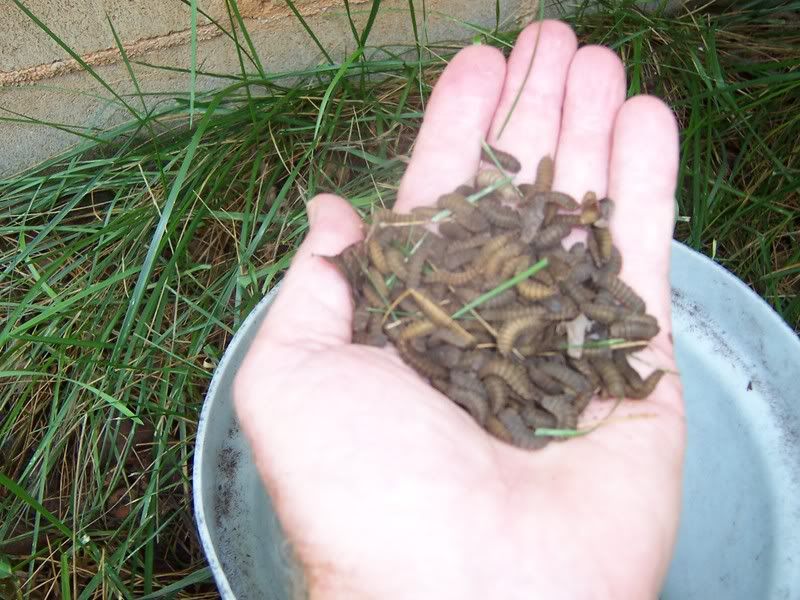 [IM
Just do it...
|
|
|
|
|
Joined: Mar 2004
Posts: 2,435
Ambassador Hall of Fame 2014  Lunker
|

Ambassador Hall of Fame 2014  Lunker
Joined: Mar 2004
Posts: 2,435 |
mmmmmmmmmmmmmmmmm ...produce 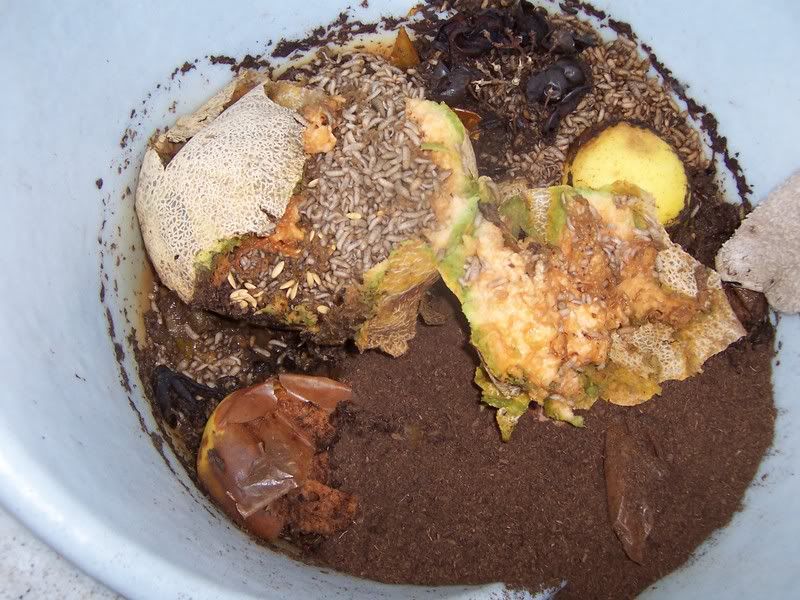
Just do it...
|
|
|
|
|
Joined: May 2008
Posts: 28
Lunker
|

Lunker
Joined: May 2008
Posts: 28 |
So I had a colony collapse. It looks like all the smaller maggots have dissappeared and the only ones I can find in abundance in my unit are larger maggots just before the pupa stage. I had a bunch of brown-rice/vermiculite cakes from a different project that started to rot, so I tossed them into the bsf unit. Within a day or two my maggot population crashed. I don't know if that was the cause of it but it's the only new thing I've introduced. Since the maggot population has declined I've seen an abundance of some tiny whitish insects that move around pretty quickly. I was wondering if they ate the vermiculite if it would be bad for them in the same way diatomaceous earth is..?
|
|
|
|
|
Joined: Apr 2007
Posts: 2,287
Lunker
|
OP

Lunker
Joined: Apr 2007
Posts: 2,287 |
Excellent Randy, thanks for being my first customer! Your post also supports what I was preparing to tell Tweeza about how she's not alone in her fascination with BSF. It can be tricky explaining to folks that you've bonded with fly larvae so I'm glad you called them your "babies".  I'm guilty of talking to the adult flies that visit my unit, and I usually refer to them as the "girls"  (the males are rarely seen). I addressed this topic in one of my blog posts: The joy of feeding animals-nurturing black soldier fly larvae As unlikely as it sounds, feeding a black soldier fly colony taps into the fun and satisfaction you usually experience feeding more ďcuddlyĒ types of animals. I believe most people will develop something like affection for the colony after a while. Itís true that some people feel initial discomfort with the larvae but this usually changes to appreciation after a short time.
The affection Iím describing isnít so much about individual larvae, itís about the colony as a whole. When you keep a BSFL colony a relationship is created where you provide them with food and they provide the service of processing your garbage Randy I don't generate much vegetable/fruit waste so I don't get much liquid in my unit at all. I plan on testing ways to limit the amount of tea produced for those who don't want to use it. I'm thinking in terms of reserving dry discards like stale bread, cereal, grains, etc to add as needed to soak up the liquid. I also want to test various inert materials like fine sawdust and such to see if the larvae will consume it even though they can't digest it. Tweeza, hi and welcome! My crash - What I referred to as a crash was an invasion of house flies and blow flies. Of course I caused it all by adding 4 lbs of dead fish that had been floating in a pond for three days in the summer heat. The usual repellent that the BSF larvae produce was overwhelmed by the stinky fish. The BSFL consumed the fish in 36 hours but there was a bad odor that lingered for a few weeks and the pest flies were present during that period. I didn't like it. You can read more about it here. You won't be able to maintain a BSF colony in a typical compost bin because the second a larva can't find acceptable food it will simply leave. Also the decomposing leaves and grasses create heat that repels the BSFL. A well designed bio-composting unit needs to contain the larvae, even if they get impatient. This is something the BioPod does much better than my homemade unit. I doubt that the BSFL would ever tire of eating cantaloupe. Maybe they were driven off by ants or the heat. One thing BSFL are definitely not is picky about what they eat.  I think it's great that you're selling the larvae. Did you know that they're marketed on the internet as "Phoenix worms"? Last time I checked you could get 100 larvae delivered for $6. I currently have tens of thousands of them.  I think they usually sell the immature larvae (light colored) because they're softer and somewhat more attractive to reptiles and fish. I've had good luck feeding the prepupae to fish and toads, most critters just prefer the light ones. It's a lot easier to collect the prepupal larvae because they're the ones that self harvest. You might want to test the Styrofoam containers by holding the larvae in one for several days. Most likely the BSFL will be able to break it up by constantly trying to squeeze themselves into the tiny cracks. The Alka Seltzer sound is of course caused by their churning and I suggest adding some sawdust or similar bedding material. If you do that they will calm down. They can live for several weeks in a container but they might need some moisture occasionally if they're in air conditioning. They do best at 75% humidity and A/C can dry them out too much. Caution; they can and will climb straight up a vertical surface if it's wet. That's another advantage to sawdust. Maybe your husband should call my girlfriend so she can talk about how I sometimes stare at a container of maggots for 15 minutes at a time.  She is a science person (veterinarian) so she gets it, but she still teases a little, which I like. Now that I have my blog going I'm meeting several people who share our fascination with this neat bug. Hey there mrgrackle, good to hear from you. I'm afraid you will never be able to maintain a consistent BSFL colony in a perforated container as I mentioned above. I doubt that the vermiculite was the culprit, I think the larvae just decided to look for food elsewhere. 

|
|
|
|
|
Joined: Mar 2004
Posts: 2,435
Ambassador Hall of Fame 2014  Lunker
|

Ambassador Hall of Fame 2014  Lunker
Joined: Mar 2004
Posts: 2,435 |
Peat moss might work in the bottom of the unit to soak up the "tea". I used some in the bottom of the collection bucket to soften their fall. 
Just do it...
|
|
|
|
|
Joined: Apr 2007
Posts: 2,287
Lunker
|
OP

Lunker
Joined: Apr 2007
Posts: 2,287 |
I used some in the bottom of the collection bucket to soften their fall.  Awwwwww.  At any rate the Peat should work to stop them from constantly crawling in circles.
|
|
|
|
|
Joined: May 2008
Posts: 28
Lunker
|

Lunker
Joined: May 2008
Posts: 28 |
Hey there mrgrackle, good to hear from you. I'm afraid you will never be able to maintain a consistent BSFL colony in a perforated container as I mentioned above. I doubt that the vermiculite was the culprit, I think the larvae just decided to look for food elsewhere.  Heheh... I doubt they just decided to look for food elsewhere. This is the 2nd year that I've had bsf in these perforated garbage cans. This is the first time I've tried to actively increase their numbers but even last year when I didn't care about their presence either way they wouldn't leave. I understand that you're selling the Biopod and you started this thread (as well as a few on some other boards I frequent...? nanfa.org, backyardaquaponics.com.. could be a different biopod guy) but lets not make things up and say you can't keep a consistant bsf colony in a perforated container. The cool thing about the biopod is the way it collects the pupa, but if someone wants to keep a colony of bsf it can be done easly without a biopod (at least in Texas where I live)
|
|
|
|
|
Joined: Apr 2007
Posts: 2,287
Lunker
|
OP

Lunker
Joined: Apr 2007
Posts: 2,287 |
I understand that you're selling the Biopod and you started this thread (as well as a few on some other boards I frequent...? nanfa.org, backyardaquaponics.com.. could be a different biopod guy) but lets not make things up and say you can't keep a consistant bsf colony in a perforated container.
mrgrackle, I've been asked by a few people why the BSF larvae in their compost bins either disappeared or nearly did so. It happens in compost bins and I believe it would be a very rare occurrence in a properly designed BSF unit. I agree that my use of the word "never" was inaccurate, but to say I'm making things up is also not completely accurate and perhaps a bit rude. So I had a colony collapse. It looks like all the smaller maggots have dissappeared and the only ones I can find in abundance in my unit are larger maggots just before the pupa stage. A perforated container allows the larvae to leave when conditions become less favorable. That could happen if the food supply is interrupted, if the compost gets too hot, or if other insects such as ants invade it. A more closed container reduces or eliminates these factors. Even in my homemade unit I've seen large numbers of immature larvae migrate into the collection bucket, but I still had control of them. When I say a consistent colony I mean a steady population like the 10's of thousands of individuals I've maintained at one time in a 12 X 20 X 14 inch container. My homemade unit is much more efficient for raising BSFL than a compost bin and the BioPod is more efficient than my design. I'm happy if you or anyone else wants to encourage BSF in their compost bins, just don't expect it to perform on the same level as a BioPod or homemade equivalent. I've spent a huge amount of time and energy giving away what I've learned about BSF. I've coached people about what they need to consider if they choose to build their own BSF unit. I sent one nanfa member (PM for name) two separate shipments of BSF eggs and larvae, at my own expense, even though he made it clear he would rather build his own unit. He's a self-proclaimed tinkerer and I'm sure he won't buy a BioPod, but he's enthusiastic about BSF so I'm encouraging him. Sure, I love the idea of selling a product I believe in, one that is manufactured by a company I believe in. If I make an incorrect statement I want people to correct me, but I expect people to do so with respect. I've enjoyed your posts up to this point mrgrackle and hopefully we can get back to sharing experiences and opinions in a way that is consistent with this forum. I've never posted on backyardaquaponics. Edit: The nanfa member offered to cover shipping both times, or to send me some of his earthworms in exchange for the BSF. I'll probably take his offer of the worms at some point when I have time to work with them.

|
|
|
|
|
Joined: Apr 2007
Posts: 2,287
Lunker
|
OP

Lunker
Joined: Apr 2007
Posts: 2,287 |
I've been feeding BSFL to my Redears everyday for about a week and they are taking them with enthusiasm. They do have a preference for the immature larvae over the coffee colored prepupal larvae. It's a lot easier to feed the dark larvae because they self harvest and they're cleaner. Now that the fish have gotten used to the immature larvae I'm going to start substituting the dark larvae. I think they'll adapt to them fairly quickly. 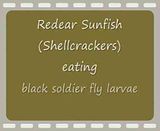 The video quality gets reduced when I upload it but if you watch carefully you can see some FH trying to hit a few of the larvae. I guess it's good to dream big.  I only have 24 large RES in my pond but they're concentrated in one place for spawning. The small RES in the video are the 1 1/4 inch fish I stocked in late March.
|
|
|
|
|
Joined: Mar 2004
Posts: 2,435
Ambassador Hall of Fame 2014  Lunker
|

Ambassador Hall of Fame 2014  Lunker
Joined: Mar 2004
Posts: 2,435 |
Lookin' good. My HBG & Redears prefer the lighter colored larvae too, but don't get them very often, and are very happy to pound the black ones. They'll eat what I feed them and like it, or else!! 
Just do it...
|
|
|
|
|
Joined: May 2004
Posts: 13,975 Likes: 277
Moderator Lunker
|

Moderator Lunker
Joined: May 2004
Posts: 13,975 Likes: 277 |
A man who hand-feeds his Redears can't be all bad. (sniff) 
"Live like you'll die tomorrow, but manage your grass like you'll live forever." -S. M. Stirling ![[Linked Image from i.pinimg.com]](https://i.pinimg.com/736x/ed/b5/e7/edb5e7f935843b996cf52be593c9ebd2--smoothie-smooth-collie.jpg)
|
|
|
|
|
Joined: May 2008
Posts: 28
Lunker
|

Lunker
Joined: May 2008
Posts: 28 |
it was a bit ruderer then i ment, but i think it's silly to say the the biopod is such a better place for raising bsf maggots. the only thing the biopod does better then a decent homemade unit is help harvest the maggots.
to have a decent homemade unit all you need is:
1. make sure the container isn't to big/small for the amount of feed you add.
2. make sure it's ventilated to help get rid of heat.
3. make sure the female can lay eggs in a place where the hatched maggots can easily find food. this is easily accomplished with step 2.
4. if you're feeding them foods that contain a lot of water you need to account for the liquid they release. btw, i've yet to see this 'tea' help my plants. i really do hope it does.. I'm actually letting a gallon of it 'finish composting' and them I'm going to apply it to some plants in a more controlled way then i did last time.
drawbacks I see to the Biopod...
1. expensive
2. with the biopod you're kinda stuck with the size of the compost area. if you have a lot more or less compost, you may run into problems... i guess you could buy the more expensive, yet larger, biopod version. is that one in production yet?
2. you can build very efficient units from recycled materials around your own area. These units are built in.... Vietnam right? Maybe the wrong country but they are being built in SE Asia. Globalism/consumerism and a lot of shipping things around the world. I dug my unit out of large trash pickup in my neighborhood.
3. doesn't address the problem of waste disposal in poor rural communities where this sort of technology would be HUGE just for the sanitation point of view. bsf should be able to be put to use with items people find right around their area for cheap. i've seen this done with biogas to turn human waste into cooking/lighting gas fuel.
I've also come up with my own solution to harvesting maggots. I drink coffee every morning and the maggots love coffee. Every night I put my coffee grounds in a small plastic starter pot and then set that on the top of the compost in my bsf unit. During the night the maggots crawl up through the holes in the bottom of my pot and the next morning the pot's absolutely teaming with maggots. I just through the maggots/coffee grounds into the fish together. This also allows me to feed my fish maggots in all life stages, not just the huge/hard pupa that are heard to eat for smaller fish.
Like I said, I think the biopod is a cool deal. Whenever I think about designing a bsf unit I do think about how the biopod does it. but ultimately i don't think it's any more necessary to have a biopod to successfully raise bsf then to have one of those expensive compost tumblers to make compost. i also think people need to be careful about claims they make.. the bsf tea is one thing ive seen described as great fertilizer, yet i've to see any noticable or provable result.
another thing i have a personal aversion to is sending bsf to places where there aren't any bsf already. i live in texas and we used to not have fire ants, killer bees, asian tiger mosquitoes, tilapia, zebra mollusks, hydrilla, duckweed, camels... ok, who doesn't like camels lol. the road to hell is paved with good intentions.
|
|
|
|
|
Joined: Mar 2004
Posts: 2,435
Ambassador Hall of Fame 2014  Lunker
|

Ambassador Hall of Fame 2014  Lunker
Joined: Mar 2004
Posts: 2,435 |
mrgrackel, I am a satisfied customer of the Biopod unit, because it is cleaner and neater than my homemade unit, and it saves me time. Probably 1/2 hour a day - in a week or so it has paid for itself. Sure my old system was ok, but I wanted to upgrade. That's the great thing about living in this wonderful country - you can say whatever you want to, and you don't have to buy a Biopod unit if you don't want to. We're just talking about maggots - lighten up. 
Just do it...
|
|
|
|
|
Joined: Apr 2007
Posts: 2,287
Lunker
|
OP

Lunker
Joined: Apr 2007
Posts: 2,287 |
i think it's silly to say the the biopod is such a better place for raising bsf maggots. Based on what? I've shown you one recent post by someone who's colony disappeared from his compost bin. Just a few posts ago in this thread someone related how ants had entered her compost bin. If nothing else the ants represent competition for the BSFL. That's less efficiency. Your method for collecting larvae is great and I've used it myself for the immature larvae, but it still requires forethought and a number of steps. That's less efficient. With my homemade unit or a BioPod you can ignore the unit for several days and still walk out to it, open a bucket and remove the larvae. A more closed system like a BioPod is better at concentrating the info-chemicals that the BSF produce. These chemicals work to attract female BSF and to repel pest flies. Concentrating these chemicals is more efficient. mrgrackle, I'm not debating that people can build a satisfactory BSF unit with cheap materials, I've never said otherwise. I did it myself a year before I even knew BioPods would ever be available. I didn't think of it myself though, I borrowed the idea from Dr. Paul Olivier of ESR Itnl. who published details of his design on the web for all to see. After tweeking my unit for over a year I'm very familiar with it's strengths and weaknesses. Now that I have a BioPod I feel very confident in saying that the BioPod is significantly more efficient than my unit. I can raise millions of BSF larvae in my homemade unit, I can do it with more efficiency and convenience in a BioPod. Until you test a BioPod and a similar homemade unit I don't see how you can claim to understand the difference between those and a traditional compost bin. drawbacks I see to the Biopod...
1. expensive
2. with the biopod you're kinda stuck with the size of the compost area. if you have a lot more or less compost, you may run into problems... i guess you could buy the more expensive, yet larger, biopod version. is that one in production yet?
2(.5) you can build very efficient units from recycled materials around your own area. These units are built in.... Vietnam right? Maybe the wrong country but they are being built in SE Asia. Globalism/consumerism and a lot of shipping things around the world. I dug my unit out of large trash pickup in my neighborhood.
3. doesn't address the problem of waste disposal in poor rural communities where this sort of technology would be HUGE just for the sanitation point of view. bsf should be able to be put to use with items people find right around their area for cheap. i've seen this done with biogas to turn human waste into cooking/lighting gas fuel. 1. Cost is relative. My girlfriend bought a Rubbermaid garden cart last year for the exact price of a BioPod. The BioPod took years of research and testing to develop, the garden cart not so much. The cart gets used occasionally and a BioPod will function continuously for months at a time or in most cases year round. If a person used a BioPod for one year it would have cost them about $.50 per day. Use one for 3 years and the cost is more like $.17 per day. 2. ESR claims that the BioPod can process 11 lbs. of waste every day. That's a lot of organic garbage. I haven't personally added that much to my unit or a BioPod so we'll have to see if the claim is true. If you had more than 11 lbs. of waste on a given day you could still add it to the unit, but you would have to adjust with smaller amounts later on. I'm not sure I completely understand the merit of this particular criticism. All tools have a limit to what they can accomplish. The larger ProtaPod is about twice the diameter of the BioPod and handles twice the waste. It's a rare household that produces more than ll lbs of waste per day. I'm not sure if the ProtaPod is available yet. It sells for $300, roughly double the price. 2.5. It seems like the globalism/consumerism argument you put forth is being used more and more, often by people using computers made in China or other distant countries. The people using this argument against a bio-composting unit that weighs 15 lbs. ought not to be watching an imported television or an imported computer monitor, or wearing imported shoes, etc. I applaud the sentiment, but there are many many products that we need to criticize this way before we get to the BioPod. The BioPod is a practical tool that can help introduce people to a sustainable technology that they otherwise might not attempt. Dr. Olivier's ultimate goal is to eliminate landfill completely and convert a steady stream of food waste into a stream of nutritious animal feed. The BioPod is one aspect of this larger goal. Yes, the BioPod is manufactured in Vietnam where Dr. Olivier currently lives. He has worked with the government of Brazil to find a solution to sewage treatment without wasting potable water as our system does. I believe he is involved in a similar way with the government of Vietnam. If the people of Vietnam benefit from manufacturing BioPods I'm alright with it. 3. It's true that poor people can't afford a BioPod and Dr. Olivier is aware of that. Here's a quote from his company's website: Old School: Precast Concrete
The most basic way to manufacture soldier fly bioconversion units is by means of pre-cast concrete. But a pre-cast unit molded as a single part will be difficult to handle and transport. However, if molded in three vertical sections of 120 degrees, these sections are easy to handle, and they can be stacked against one another to reduce transport volume.
Another advantage of molding the unit in three sections: no metal reinforcement of the concrete is required. Since the three sections are held together by three nylon straps in much the same way that an oak barrel is held together by bands of steel, stress on the unit is relieved at the points of intersection of the three sections.
All that is needed for the fabrication of the unit is a dollar or two of cement, and recycled materials such as stone, brick or broken glass can serve as aggregate or filler. To reduce the weight of pre-cast concrete, a lightweight aggregate such as perlite and vermiculite can be used. The construction of bioconversion units could take on many of aesthetic qualities of Hypertufa: lightweight, artificial stone containers.
No Bottom
Note that the concrete unit has no bottom. The unit can be situated above a bed of sand that would serve as a partial filter, and any nutrients that escape this filter could be absorbed by the roots of plants situated around the perimeter of the unit. In this way any free liquids liberated by the larvae in the digestion of the waste do not necessitate the introduction of bulking materials. This greatly simplifies the operation of the unit.
If left out in the open, the unit must have a lid to prevent rainwater from coming in. A lid could consist of nothing but a sheet of plastic or plywood. The fasteners that hold down the metal strips at the top of the unit create sufficient space in between the unit and the lid to allow soldier fly access into the unit.
Ideal for Developing Countries
Such a unit is ideal for use in developing countries where the cost of materials is high relative to the cost of labor. Since cement is abundant and readily available throughout most developing countries, since very little skill is needed to fill a mold, small workshops could be easily set up to serve a specific area or province, thereby eliminating the costly transport of units over long distances. Our goal is to sell a unit capable of disposing of all the putrescent waste from a single household for less than $10 US dollars. Larger units could be easily constructed in the same simple manner as indicated above by changing the angle from 120 to 60 degrees, and by increasing the number of ramps from two to four. In this case, a unit would consist of six vertical sections. Since one half of a unit would identical to its other half, the entire unit could be fabricated, once again, out of three molds.
Urine-Diverting Toilet
Another big advantage of using precast concrete: the unit could easily support the weight of a pre-cast concrete lid that could incorporate all of the essential features of a urine-diverting toilet. Into the one bin goes all putrescent waste another thing i have a personal aversion to is sending bsf to places where there aren't any bsf already. I think that's a valid concern, but from what I've read there is almost no place in the continental US that doesn't already have black soldier flies. There is certainly nothing stopping them from naturally migrating. I've put thought into this important issue and I still can't imagine what negative effects a larger population of BSF would produce. I think the species that would suffer the most from increased BSF would be the house fly. House flies are fairly dependent on human activity and replacing this disease carrying pest with a non-pest cousin sounds like more of a solution to me than a problem. I could be wrong about this and I welcome any evidence that might support the idea that encouraging the BSF population is harmful. mrgrackle, like you I'm very skeptical about people's motivations, especially when there is profit at stake. I don't object to your questions and I pardon any lapses in politeness. Most of your points warrant an explanation and I'm happy to provide them to the best of my ability. Of all the people I've corresponded with you seem to be the most experienced and knowledgeable about BSF, unfortunately you have no experience with a BioPod. Maybe someday you'll get one or build a copy of one and at that point I'll be even more interested in your observations.

|
|
|
|
|
Joined: Mar 2004
Posts: 2,435
Ambassador Hall of Fame 2014  Lunker
|

Ambassador Hall of Fame 2014  Lunker
Joined: Mar 2004
Posts: 2,435 |
Feed 'em some lighter colored larvae today and a couple came out of the water with excitement.... 
Just do it...
|
|
|
|
|
Joined: Apr 2007
Posts: 2,287
Lunker
|
OP

Lunker
Joined: Apr 2007
Posts: 2,287 |
Nice photo! Randy, soon I'm planning on bypassing the collection bucket and directing the larvae into a pipe that extends over the pond so they will automatically drop right in. I would like to test it with 200 - 300 feet of pipe to see if a BSF unit could be set up that far from a pond and still work automatically. With a set up like that the only time you would have to collect larvae is when you want a few for bait or to get some immature larvae. I'll bet you could have caught a few of those fish if the larvae had hooks in them.  (tied to line of course)
|
|
|
|
|
Joined: Aug 2004
Posts: 8,854 Likes: 1
Moderator Ambassador Field Correspondent  Lunker
|

Moderator Ambassador Field Correspondent  Lunker
Joined: Aug 2004
Posts: 8,854 Likes: 1 |
Holding a redear sunfish is like running with scissors.
|
|
|
|
|
Joined: Mar 2004
Posts: 2,435
Ambassador Hall of Fame 2014  Lunker
|

Ambassador Hall of Fame 2014  Lunker
Joined: Mar 2004
Posts: 2,435 |
Thanks, some of the fish will jump completely out of the water.
GW, I haven't fished from the dock yet (kind of a poor man's VIP dock), but if I want to sample, I just cast to it from shore. You catch something every cast. They are very aggressive.
Would the 200-300 foot pipe have enough oxygen or get too hot?
Does sound like a good idea.
Just do it...
|
|
|
|
|
Joined: Apr 2007
Posts: 2,287
Lunker
|
OP

Lunker
Joined: Apr 2007
Posts: 2,287 |
I've been picturing 1 inch pvc and I'm not sure what the inside temperature could be on a hot day. I think the best way to accommodate a long pipe would be to bury it anyway which would take care of that problem. As long as the pipe wasn't angled sharper than about 40 degrees anywhere you could come out of the ground and up the back of a dam. You could also run it underground to a dock, then along the side of it and out over the water. I think it would concentrate some fish there. If you want the larvae further out you could possibly support the pipe with something like "noodles" for flotation and run it on the water. You would turn the pipe up at the end to keep waves out and back down a short distance to keep rain out. A small amount of water in the pipe won't stop the larvae. Now that I think about it maybe you could somehow anchor the pipe below the surface so you don't have to look at it, and then turn up out of the water at the end. Anyway, you get the idea. 
|
|
|
|
|
Joined: Apr 2007
Posts: 2,287
Lunker
|
OP

Lunker
Joined: Apr 2007
Posts: 2,287 |
It's not easy being black soldier fly... 
Last edited by GW; 07/25/08 07:06 PM.
|
|
|
|
|
Joined: Jul 2008
Posts: 5
Fingerling
|

Fingerling
Joined: Jul 2008
Posts: 5 |
My humble 2 cents:
You can raise BSFL in a barrel with lots of holes but you would need to assess your needs. I have one of those barrels and at first it was great. I'm new to composting and I'm not embarrassed to say, Iím not very good at it. When I found the BSFL and figured out what they were I was pretty happy. They made quick work of all the cantaloupe waste we had and a lot of other stuff and I donít have to worry about putting anything else (i.e. grass clipping or whatever else youíre supposed to put into it) into it and no turning! It wasnít until I put a hot water heater pan under it that I got serious and also started to have problems. My herd is not as extensive as it once was and Iíve been loosing a lot of tiny larvae into the water. The adults are easy to get out because of their weight the little ones are like trying to catch tiny pieces of Styrofoam, itís next to impossible. Next time I go to town Iím getting a turkey baster.
This barrel system is not very efficient. It was okay when I was just looking to compost kitchen waste but now that Iím harvesting them itís another story. Iíve been plucking these little darlings out of the water one and two, sometimes three, at a time. Itís a pain and time consuming. I do this morning and evening. I tried putting some ramps on the inside of the barrel but alas they prefer going out the holes. To those of you who are handy with being able to design things and then to be able to make them, Iím jealous!
Last night a frog jumped into the water so Iím supposing theyíre steeling my larvae. If itís not one thing itís another with this system.
Now for my really good news, I told my husband I sold some more larvae. He said, ďWOW, in ten times youíd have that thing paid for.Ē My reply was, ďyah, and it wouldnít take me as long and I wouldnít be sitting here scooping out larvae.Ē I should have mentioned it would give me more time to clean the house but didnít think of it until just now. That might have helped him to decide to get me a Biopod faster! Heís thinking about it so I hope I wonít have to wait for Christmas. He got online and was looking at them. Iím pretty excited.
One question though, GW. After awhile how do you get out the stuff they donít consume and their waste? I figure you wouldnít have to empty the whole thing just enough to lesson the volume. I asked this question on your blog but Iím not sure it went through. Oh, and I told my husband we had to get the Biopod through you. Iím sure Iíll need all the support I can get and I know youíre able to give it (I wonít go into my story as that would be off topic, of the BSFL that is).
Thanks
Tweeza
|
|
|
|
|
Joined: Jul 2008
Posts: 5
Fingerling
|

Fingerling
Joined: Jul 2008
Posts: 5 |
Do you know if BSFL like onions? Also, just harvested our fennel and found it's pretty much useless for what we wanted it for, do you think it would be okay to give to the larvae? It smells just like licorice (yum). You wouldn't think anything would repulse them but what about the adults?
Tweeza
|
|
|
|
|
Joined: Apr 2007
Posts: 2,287
Lunker
|
OP

Lunker
Joined: Apr 2007
Posts: 2,287 |
Tweeza, one thing to consider with your catch pan is that if the sides are damp you probably also have larvae crawling out of it. They can't climb a vertical surface unless it's damp. That's why it's recommended that you keep sawdust or similar bedding in a collection bucket. mrgrackle described a good method for collecting the immature, light colored larvae. Here's a few photos that show my sophisticated immature larval collection system: The collector with fish pellets placed on BSF compost: 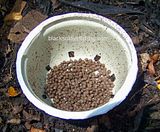 After 2 minutes: 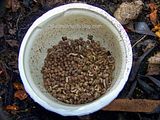 11 minutes: 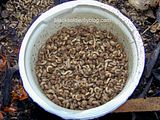 After 40 minutes: 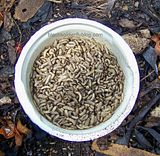 I'm not sure what to recommend for separating the larvae from the compost. I think a good approach might be like what is done with earthworms where you attract them to specific areas with fresh food. As you can see by my photos the larvae will migrate to certain foods very quickly (for larvae that is  ) One idea would be to layer some fresh food in a separate container like a plastic storage box. Over the new food place a wire mesh, maybe 1/4 inch, and then empty the active BSF larvae and compost onto the mesh. Most of the larvae should migrate down to the new food pretty quickly. If you had a day or two to wait I think almost all of the larvae would move below the mesh and you would just lift the mesh out. If you had two stackable containers you could cut most of the bottom out of one and attach the mesh to the bottom. Then put the scraps in the unmodified container and then stack the one with the mesh bottom into it, making sure the mesh touches the new food. I would probably put the lid on the top container and let it sit for a day or two, checking on the progress occasionally. Tweeza, I'll help you even if you don't buy something from me. The information is free.  I appreciate your input. edit: I just saw your second post. I've read that BSF larvae will eat onions and I think they would love some fennel too. It's true the larvae can and will eat almost anything except paper and grass, but the adults don't eat anything. They only live a few days and they live off of stored fat. I've read that they drink nectar from flowers but I can't say much about that. The (dark) prepupal larvae don't eat either. In that stage they only want to find a quiet dry place to pupate.
Last edited by GW; 07/25/08 06:36 PM.

|
|
|
|
|
Joined: Apr 2007
Posts: 2,287
Lunker
|
OP

Lunker
Joined: Apr 2007
Posts: 2,287 |
Tweeza, to leave a comment on the blog just click the word "Comments" that's on the bar at the bottom of any post. It will take you to a message window where you can type what you want.
|
|
|
|
|
Joined: Apr 2007
Posts: 2,287
Lunker
|
OP

Lunker
Joined: Apr 2007
Posts: 2,287 |
Yucky but useful: Maggots make compost
Maria Gaura, Special to The Chronicle
Friday, July 25, 2008 I've been composting my kitchen waste for 20 years, and there's not much in the way of rotting food that can gross me out anymore. But last summer, the maggots appeared. Over a period of weeks I noticed a few things about my new tenants: They ate like crazy. If you tossed it in, it vanished within hours. And the compost no longer stank; it now had the mild odor of damp straw.
The maggots were very responsive; they pounced on new food and retreated from direct sunlight. You could hear them. The mass of moving larvae made a wet rustling sound, exactly like falling rain. I became rather fond of my maggots. I took frequent breaks from the computer to watch them at work, and fretted about them when we went on vacation. I found myself saying things like, "Come and get it!" when I brought out a new load of scraps. There are things you're not supposed to put in your compost pile, such as cheese, meat and oily cooked food. But I wondered what the maggots would do, so one day I cleaned out the refrigerator. My bucket was brimming with forbidden items: old sour cream, chicken parts, a wad of newspapers soaked through with bacon grease. I felt like a bad, bad gardener.
I tossed it in anyway.
An hour later I peeked in and there was a party going on. The maggots were thrashing about in a feeding frenzy. Most arresting was the fate of a fist-size ball of formerly fresh mozzarella. The maggots had tunneled into the cheese, which held its shape but quivered violently. Within a half hour it was gone.

|
|
|
Moderated by Bill Cody, Bruce Condello, catmandoo, Chris Steelman, Dave Davidson1, esshup, ewest, FireIsHot, Omaha, Sunil, teehjaeh57 |
|